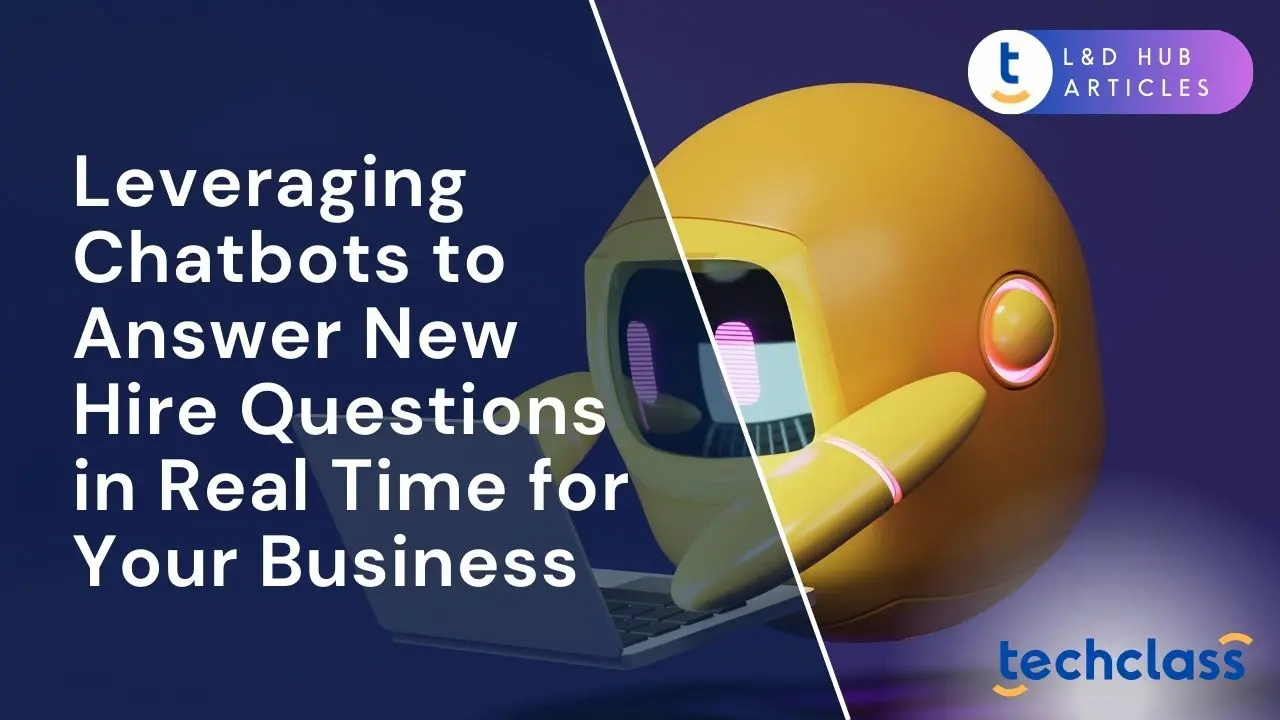
Every new hire arrives brimming with questions, from “How do I set up my email?” to “When do my benefits kick in?” In fact, HR teams often spend up to 50% of their time addressing repetitive employee queries about policies, benefits, and procedures. This avalanche of questions can overwhelm HR staff and slow down the onboarding process, especially in large or fast-growing organizations. If answers are delayed, new employees may feel confused or frustrated during their critical first days on the job. In today’s hybrid and remote work environments, the challenge is even greater: new hires might not have a colleague at the next desk to ask, and HR isn’t always immediately available across time zones.
How can businesses ensure that newcomers get the information they need instantly and consistently? An emerging solution is the use of AI-powered chatbots as virtual HR assistants. These chatbots can answer new hire questions in real time, providing on-demand information and guidance. By leveraging chatbots, companies can streamline onboarding, relieve the burden on HR teams, and help new employees feel supported from day one. It’s no surprise that organizations across industries, from tech startups to global enterprises, are embracing chatbots to enhance their employee onboarding experience. Gartner even projects that by 2025, 75% of HR inquiries will be handled via conversational AI platforms, underscoring the rapid rise of this technology in HR. In the following sections, we’ll explore how HR chatbots work, the benefits of using them to assist new hires, real-world examples of success, and best practices to implement them effectively for your business.
AI chatbots have rapidly become a game-changer in HR, acting as always-on assistants that can handle many of the routine tasks traditionally managed by HR staff. At their core, HR chatbots are software agents that use conversational interfaces (like a chat window in Slack, Microsoft Teams, or a web portal) to interact with employees. They leverage technologies such as natural language processing to understand questions and retrieve relevant answers from a database or knowledge base. This means a new hire can ask a bot, “How do I submit my timesheet?” or “What’s our dress code policy?” and get an instant, accurate response without hunting through a manual or waiting for an email reply. These virtual assistants can also guide users through processes, for example, helping a new employee complete onboarding forms or schedule required training sessions, all through a simple chat conversation.
Importantly, HR chatbots are not replacing human HR representatives; rather, they augment HR support by handling the high volume of simple FAQs and tasks, so human experts can focus on more complex, strategic work. The adoption of chatbots in HR has been swift. Surveys show that 69% of HR teams are now using AI for onboarding new employees, and most HR leaders plan to further increase their use of AI in people management. Employees are also increasingly comfortable with this technology. In one study, 62% of employees said they would prefer to use a chatbot for their HR needs, finding it quicker and more convenient for getting information. This growing acceptance suggests that a well-designed chatbot can seamlessly fit into the employee experience.
Organizations across industries have already deployed HR chatbots to great effect. For example, fast-food giant McDonald’s uses an AI assistant (affectionately named “Olivia”) to engage with job candidates and new hires via text messaging, answering their questions about job openings, company benefits, and policies. This automated assistant helps McDonald’s provide prompt answers and streamline the hiring and onboarding process. In the finance sector, loanDepot introduced a chatbot called “Elle”, which provides immediate support to new employees; during orientation, 90% of new hires at loanDepot reported that the chatbot was helpful in answering their questions and guiding them through onboarding. These examples illustrate how chatbots can become a dependable first-line resource for new staff, offering information in real time and ensuring no question goes unanswered. With the basics of HR chatbots covered, let’s delve into the specific benefits they bring to the onboarding experience.
Leveraging chatbots to support new hires offers numerous advantages for both the employee and the employer. Below are some of the key benefits of real-time Q&A during onboarding:
In summary, real-time chatbot support removes friction from the onboarding journey. It delivers instant help, consistent answers, and personalized guidance, all of which contribute to happier new employees and more efficient HR operations. Next, we’ll see how these benefits play out in practice by looking at organizations that have successfully implemented chatbots for their workforce.
Companies big and small are leveraging chatbots to enhance their onboarding and employee support, with impressive results. Here are a few real-world examples and use cases that demonstrate how chatbots answer new hire questions and streamline the onboarding experience:
These examples underscore a common theme, when implemented thoughtfully, chatbots can handle a huge volume of routine questions and tasks, making the onboarding experience faster and more uniform. Whether it’s a retail giant automating welcome messages and Q&As for frontline staff, or a corporate enterprise providing a unified HR info hub, the goal is the same: empower new hires with immediate answers and free up humans for what they do best (building relationships, tackling complex issues, and driving strategy). Next, we will discuss some best practices and considerations to keep in mind when introducing a chatbot to assist your own organization’s new hires.
Deploying a chatbot for answering employee questions can yield great benefits, but success depends on careful implementation. Business leaders, HR professionals, and CISOs should collaborate on the following considerations when rolling out an HR chatbot:
1. Knowledge Base and Training: The chatbot is only as good as the information behind it. Start by curating a comprehensive, up-to-date knowledge base of HR FAQs, company policies, onboarding checklists, and IT how-tos. Common new-hire questions about topics like payroll setup, benefit enrollment, time-off requests, org charts, and internal tools should all have clear answers in the system. During implementation, spend time “training” the chatbot on this content so it can recognize various phrasings of questions and still retrieve the correct answer. It’s wise to review chatbot responses for accuracy during a pilot phase. Involve experienced HR team members to verify that the bot’s answers are consistent with current policies. Plan for ongoing maintenance of the knowledge base, whenever a policy changes or a new frequent question pops up, update the bot’s data so it remains a reliable source.
2. User Experience and Integration: Meet employees where they are. Ideally, integrate the chatbot into platforms your workforce already uses daily, such as your corporate chat (Slack/Teams) or HR portal. This way, new hires can access help without breaking their workflow. Ensure the chatbot’s interface is easy to use and welcoming, for example, it can greet a new hire by name and offer suggestions like “I can help you find information on benefits or IT setup. What would you like to do?” Providing some guided options or clickable prompts can assist less tech-savvy users in getting started. Additionally, integrate the chatbot with your HRIS (Human Resources Information System) and other relevant systems so that it can personalize answers and even perform tasks. For instance, the bot could pull an employee’s remaining PTO balance from the HRIS when asked “How many vacation days do I have left?” or submit a request on their behalf. Such integrations make the chatbot far more powerful and convenient, turning it into a true self-service portal for new employees. The smoother the user experience, the more readily your new hires (and existing staff) will adopt the chatbot as a go-to resource.
3. Privacy and Security: Given that HR chatbots deal with personal and sometimes sensitive data (employee IDs, contact info, benefits details, etc.), security is paramount. Involving your Chief Information Security Officer (CISO) or IT security team early is crucial. You’ll want to ensure the chatbot and its underlying platform comply with all relevant privacy regulations (such as GDPR or HIPAA, if applicable) and that robust security measures are in place. This includes secure data storage, encryption of data in transit and at rest, and strict access controls for both the chatbot and any integrated systems. In practice, that might mean verifying that the vendor providing the chatbot has certifications like ISO 27001 or SOC 2, and that chat logs or personal data are stored safely. Limit the data the chatbot can access to only what’s necessary to answer questions or perform its functions. For example, the bot might need to know an employee’s department to answer a question about the correct IT support contact, but it likely doesn’t need full salary records. Implement role-based access so that only authorized personnel can see conversation logs or intervene if escalation to a human is needed. By prioritizing security and privacy, you maintain employee trust, staff (especially in regulated industries) will feel more comfortable using the chatbot if they know their questions and data are handled confidentially and safely. As one industry guide advises, ensure your HR chatbot uses encryption and proper permissions to keep sensitive data safe. This is particularly important to assuage any concerns from leadership and to get buy-in from the CISO that the solution meets the company’s security standards.
4. Change Management and Communication: Introducing an AI chatbot represents a change in how employees access information. Some employees might be hesitant to trust a bot or simply forget it’s available. To drive adoption, it’s essential to communicate the chatbot’s purpose and benefits clearly. Announce the new tool through internal communications, explain that it’s there to provide quick help, and give examples of the kinds of questions it can answer or tasks it can assist with. Offer a brief training or demo for new hires (and even existing employees) on how to use it. For instance, during orientation, you could have the new hires ask the chatbot a few sample questions so they become familiar with it. Encourage managers and HR reps to remind their teams to “Ask the chatbot” for common queries. Additionally, start with a phased approach: maybe launch the chatbot to handle a specific set of FAQs first, then expand its capabilities as people get comfortable. Monitor usage and gather feedback, see what questions are being asked, where the bot might be failing to answer, and collect user input on their experience. This data will help you continuously improve the bot’s performance and also identify if certain information is still hard to find (indicating perhaps a need to further simplify the process or do additional employee education). By managing the change thoughtfully, you can increase employee buy-in. Over time, as employees see the bot accurately answering their questions and saving them time, they’ll naturally turn to it as a trusted helper in their day-to-day work.
5. Keep the Human Touch: Finally, balance automation with the human element. Chatbots shine at routine Q&A, but new hires also need human interaction to truly feel welcomed into the company culture. Make sure your chatbot is configured to hand off to a human HR representative if it encounters complex or sensitive inquiries (for example, a personal concern that isn’t answered by an FAQ). Let employees know that the bot is not meant to replace HR, but to supplement it. For example, a welcome message might say, “Hi, I’m Ava, your HR assistant. I can answer most of your general questions instantly. If I can’t help, I’ll connect you with our HR team.” This assures users that there’s a safety net and that they can always reach a real person for nuanced discussions. Many organizations find that freeing HR from basic questions actually enables more human touch where it matters, HR can devote more time to one-on-one mentoring, check-ins, and building relationships, because the bot is handling the busywork. Emphasize this point to your HR staff as well, so they view the chatbot as a partner rather than competition.
By paying attention to these areas, knowledge accuracy, user experience, security, change management, and maintaining empathy, you can set up your HR chatbot for success. When implemented correctly, a chatbot becomes a natural part of the onboarding ecosystem: new hires get immediate answers and guidance at their fingertips, and your HR team can focus on ensuring those employees feel truly integrated and supported in the company.
In conclusion, leveraging chatbots to answer new hire questions in real time can transform the onboarding experience for both employees and HR departments. The early days and weeks of a new job are when employees form lasting impressions and often need the most help. An AI-powered HR chatbot serves as a friendly, knowledgeable guide during this period, available any time to provide information, clarify doubts, and even automate simple tasks. By doing so, it not only increases the new hire’s confidence and satisfaction, but also lightens the load on HR teams, allowing them to invest energy in more personalized and strategic initiatives.
For HR professionals, CISOs, and business owners, the message is clear: chatbots represent a valuable tool at the awareness stage of digital HR transformation. They illustrate how thoughtful automation can enhance human processes rather than replace them. Companies that have adopted HR chatbots are seeing faster onboarding, higher retention, and a more empowered workforce. Embracing such technology positions your organization as innovative and responsive to employee needs. Of course, success requires careful planning, from maintaining accurate content to safeguarding data, but the payoff is a more efficient onboarding workflow and a better first experience for every new team member.
As workplaces continue to evolve, especially with remote and global teams, providing real-time support will be increasingly important. An HR chatbot is an investment in communication and knowledge-sharing infrastructure that grows with your business. It ensures that no question is too small or too “silly” to be answered, and that help is always just a quick message away. By leveraging chatbots for onboarding, you empower your new hires to hit the ground running and signal that your organization is committed to their success from day one. In today’s competitive talent landscape, that can make all the difference in building an engaged, high-performing team right from the start.
An HR chatbot is a virtual assistant that uses AI to answer employee questions in real time. During onboarding, it provides instant, accurate answers about company policies, benefits, and procedures, helping new hires get up to speed quickly while reducing repetitive queries for HR staff.
Key benefits include 24/7 availability, consistent and accurate answers, reduced HR workload, improved new hire confidence, and faster ramp-up to productivity. This leads to a smoother onboarding experience and higher employee engagement.
Yes. Well-designed HR chatbots can integrate with platforms like Slack, Microsoft Teams, or an HR portal, as well as HRIS systems. This allows them to personalize answers, retrieve employee-specific data, and even complete tasks like submitting time-off requests.
Yes, if implemented with proper safeguards. This includes encryption, secure data storage, role-based access controls, and compliance with privacy regulations like GDPR. Involving IT security teams during setup ensures sensitive employee data remains protected.
No. HR chatbots handle routine, repetitive questions so human HR professionals can focus on complex issues, relationship building, and strategic work. They are designed to complement, not replace, human interaction, and can escalate issues to HR staff when needed.


